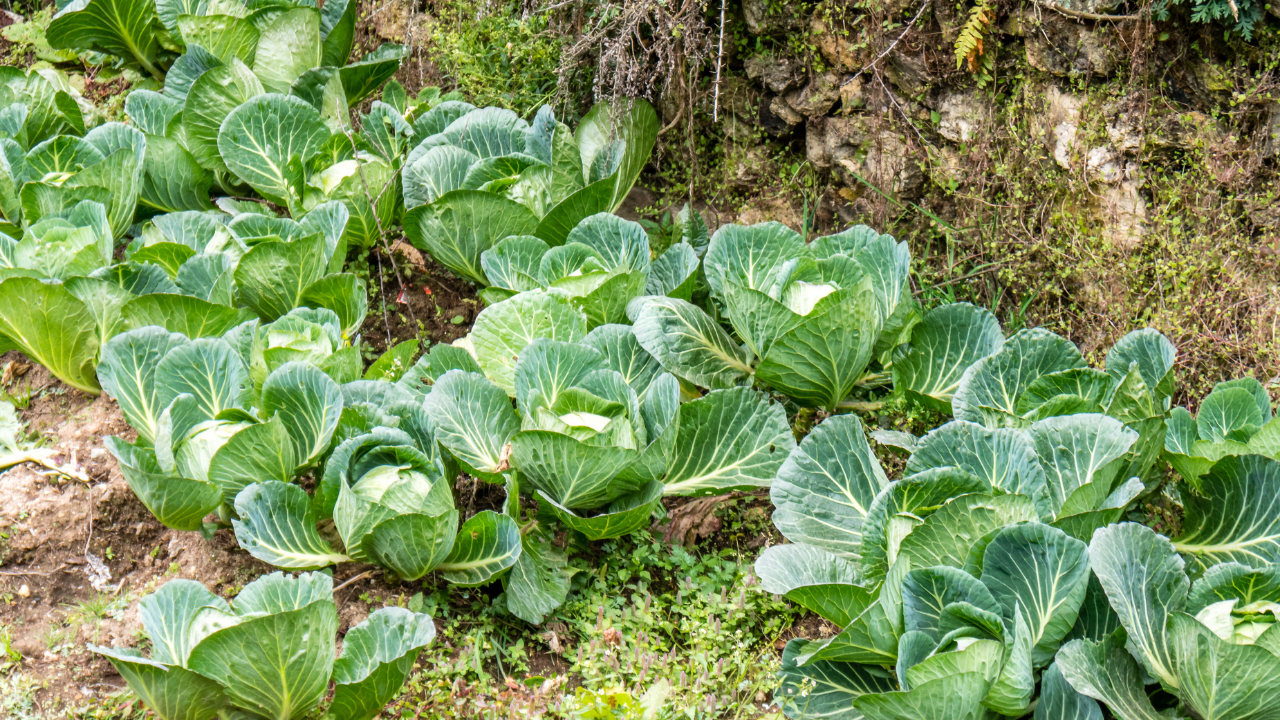
By starting to grow cabbage first thing in the spring, you’ll be able to speed up your harvest so that it’s ready to be pulled by the middle of the summer - before it gets too hot!
Growing cabbage isn’t complicated, especially if you already have some experience in growing a backyard vegetable garden.
Here are some tips to help you get started.
Sowing Cabbage Seeds

Technically a hardy biennial, cabbage is typically grown as a cool-weather annual. It does not do well with intense heat but can tolerate a frost.
Because of this, it is best to start cabbage seeds indoors about four to six weeks before the last spring frost. Sow seeds about half an inch deep spaced one inch apart. Later, you can thin your seeds to 18 to 24 inches apart.
Keep the seedlings well watered until they germinate. They should be kept warm during this time, too, generally around 50 to 75 degrees.
You can also sow cabbage seeds directly outdoors. This can be done as soon as the soil can be worked, but starting indoors presents an advantage in that you can get your seeds started when there is still snow on the ground. Remember, cabbage bolts and goes to seed in temperatures greater than 80 degrees, so you need to give it plenty of time to grow in cool weather.
Best Place to Plant Cabbage
Plant cabbage in a place where the soil pH is between 6.5 and 6.8. Full sunlight is preferred, as is soil that is rich in nitrogen.
When to Plant Cabbage
Cabbage can be planted four to six weeks before the last spring frost if you are starting seeds indoors. If you are growing directly in the garden, seeds or transplants can be set out as soon as the soil is workable.
Best Varieties of Cabbage to Grow
There are several varieties of cabbage you can grow, each of which offers unique benefits to gardeners.
If you’re looking for a red cabbage variety, consider one of the following options:
- Red Ball
- Red Ribbon
- Red Acre
- Ruby Perfection
For savoy cabbage, you really can’t beat Savoy King or Savoy Ace, both of which take around 80 to 85 days to reach maturity.
And for gardeners interested in the classic type of cabbage, green cabbage, you might want to consider growing:
- Jersey Wakefield
- Stovehead
- Golden Acre
- Green Boy
- Market Price
- Round-Up
- Blue Boy
- Blue Ribbon
- Badger Ban Head
- Rio Verde
- Flat Dutch
Transplanting Cabbage

Cabbage plants can be transplanted in the garden when they are three to four inches tall, usually as soon as three to four weeks prior to the last frost in the spring. You can of course plant after this time as well, but you will want to get your plants in the ground early so they have plenty of time to grow before the heat sets in.
Transplant to the garden by burying them deeply, burying one to two inches of the main stem (perhaps more if your seedlings grow leggy when you start them indoors).
You can plant all of your cabbage at once or you can plant in succession, planting every two weeks so the plants are ready for harvest at varying times.
Caring for Cabbage Plants

There are a few steps you should take to care for your cabbage plants once they are in the ground, but the good news is that cabbage is a relatively hardy, self-sufficient plant.
Watering
Water your cabbage plants regularly - these plants require regular, consistent, and even watering. Watering inconsistently can cause your cabbage to develop weak, undersized, or cracked heads. About one to one and a half inches of water per week is all that is needed to keep plants healthy.
There is one exception to this watering rule - as your cabbage plants reach maturity, slow down on the watering. Too much water close to harvest time can cause the heads to split.
Fertilizing
Cabbage can be fertilized in the middle of the growing season. Use a high-nitrogen fertilizer to encourage leaf growth. Fish emulsion is a great option to consider.
Pests and Diseases
Cabbage is prone to several different kinds of diseases and pests, with common insect pests including cabbage root maggots, cutworms, cabbage loopers, cabbage worms, and aphids. You can prevent pests by keeping your plants healthy and by placing protective collars around young plants to deter cutworms and other crawling pests. You can also apply a layer of diatomaceous earth to keep pests away.
When it comes to diseases, watch out for black rot and clubroot. Both of these are fungal diseases that can be prevented by growing in well-draining soil with plenty of space between each individual plant. Rotating your crops can also keep these diseases away.
Other Care Tips
Mulch your cabbage plants in warm weather. This will preserve soil moisture and will keep the soil cool as the weather heats up. Use an organic mulch like straw or hay, mulching to two or three inches deep.
Consider growing cabbage alongside companion plants like potatoes, onions, celery, beets, and herbs. Avoid planting near other plants in the brassica family (like broccoli, cauliflower, and brussels sprouts) as they attract similar pests and diseases.
Growing Cabbage in Containers

Cabbage can also be easily grown in a container. The container should be at least eight inches deep and wide. If growing in a container, take extra precautions to make sure the soil doesn't dry out - containers speech both water and nutrients more quickly than their garden-grown counterparts. You may also want to feed cabbage with a diluted compost tea every two weeks.
Harvesting Cabbage

Have you ever wondered how long to grow cabbages? Harvest times vary between different types of cabbage, but they are usually ready to be harvested in 80 to 180 days if you are growing from seed and 60 to 105 days if you grow transplants.
Cut your cabbage plants when the heads are firm and the base of each head is at least four inches across (ideally no more than ten). Harvest before it gets warm - the earlier you harvest, the sweeter your cabbage will be.
You can also cut individual leaves from your cabbage plants if you choose.
Best Ways to Use Your Fresh Cabbage

Depending on the type of cabbage plants you decide to grow, your plants may last as little as a week or several months in cold storage. Some varieties are best stored in the refrigerator while storage varieties can be kept in a cool, dark location like a basement or root cellar (provided that it is dry).
You can freeze cabbage, dry it, or cure it in brine - who doesn’t love some delicious sauerkraut?
Of course, the best way to enjoy cabbage is to eat it fresh. It’s delicious steamed, sauteed, or in a salad - be sure to give several recipes a try so that you can discover a few new favorites!
Are you interested in growing your very own Leafy Greens? We got our very own Lettuce and Leafy Greens Seed Packs for you that is available via our website or via Amazon.





